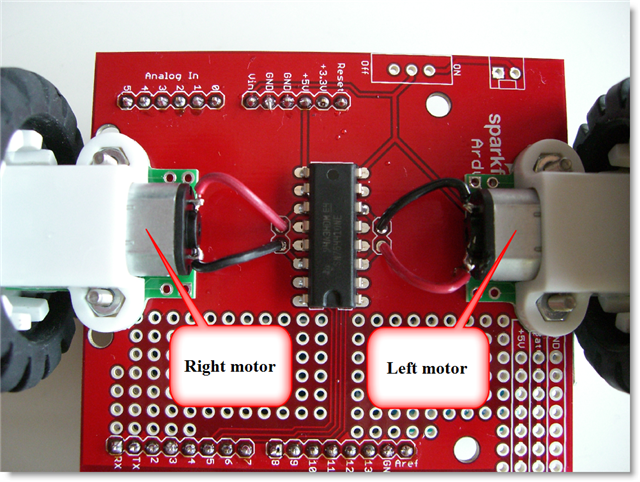Here’s a small post with extra details on building an Ardubot; details I didn’t find online.
The missing info is which Arduino output lines control the 2 motors. Measuring with a multimeter reveals digital outputs 3, 5, 6 and 9.
I place and solder the motors like this:
The +-sign closest to the PCB:

Red wire soldered to + connector, black wire soldered to – connector:

I defined left motor and right motor like this:

And here’s the schema:

To power the left motor in a forward drive, set digital output 9 high and digital output 6 low.
To power the left motor in a reverse drive, do the oposite of a forward drive (9 low and 6 high).
To power down a motor, set both digital outputs low.
To power the right motor in a forward drive, set digital output 5 low and digital output 3 high.
To power the right motor in a reverse drive, do the oposite of a forward drive (5 high and 3 low).
Arduino code:
/*
Ardubot motor-driving example program
Version 0.0.1
Source code put in public domain by Didier Stevens, no Copyright
https://DidierStevens.com
Use at your own risk
History:
2009/08/21: Start development
2009/08/23: refactoring
*/
unsigned char PIN_HBRIDGE_1A = 9;
unsigned char PIN_HBRIDGE_2A = 6;
unsigned char PIN_HBRIDGE_3A = 5;
unsigned char PIN_HBRIDGE_4A = 3;
void MotorLeftStop()
{
digitalWrite(PIN_HBRIDGE_1A, LOW);
digitalWrite(PIN_HBRIDGE_2A, LOW);
}
void MotorLeftForward()
{
digitalWrite(PIN_HBRIDGE_1A, HIGH);
digitalWrite(PIN_HBRIDGE_2A, LOW);
}
void MotorLeftReverse()
{
digitalWrite(PIN_HBRIDGE_1A, LOW);
digitalWrite(PIN_HBRIDGE_2A, HIGH);
}
void MotorRightStop()
{
digitalWrite(PIN_HBRIDGE_3A, LOW);
digitalWrite(PIN_HBRIDGE_4A, LOW);
}
void MotorRightForward()
{
digitalWrite(PIN_HBRIDGE_3A, LOW);
digitalWrite(PIN_HBRIDGE_4A, HIGH);
}
void MotorRightReverse()
{
digitalWrite(PIN_HBRIDGE_3A, HIGH);
digitalWrite(PIN_HBRIDGE_4A, LOW);
}
void setup() {
pinMode(PIN_HBRIDGE_1A, OUTPUT);
pinMode(PIN_HBRIDGE_2A, OUTPUT);
pinMode(PIN_HBRIDGE_3A, OUTPUT);
pinMode(PIN_HBRIDGE_4A, OUTPUT);
}
void loop(){
MotorLeftStop();
MotorRightStop();
delay(2000);
MotorLeftForward();
delay(2000);
MotorLeftStop();
delay(2000);
MotorLeftReverse();
delay(2000);
MotorLeftStop();
delay(2000);
MotorRightForward();
delay(2000);
MotorRightStop();
delay(2000);
MotorRightReverse();
delay(2000);
MotorRightStop();
delay(2000);
delay(5000);
}
One tip: if you use the large wheels, get a header kit to raise the Arduino Duemilanove, otherwise the wheel will block access to the power and USB connectors:

Does this mean you cant control both the motors simultaneously? Is there any reference or code for that?
Comment by r3f3ctionz zzzz — Thursday 24 February 2011 @ 0:54
@r3f3ctionz Yes, take a look at my code.
Comment by Didier Stevens — Thursday 24 February 2011 @ 9:40
Hi, I used your code to make my ardubot work but I did something wrong in the actual circuit I think because I can control the right wheel but I can’t control the left wheel because every time the right wheel is on the left wheel turns on and never stops, I think is because of a short circuit but I’m not sure what went wrong. Any suggestions? Thank you
Comment by Anonymous — Thursday 6 October 2011 @ 16:20
That sounds like a short circuit. Have you inspected your soldering points?
Comment by Didier Stevens — Thursday 6 October 2011 @ 18:41